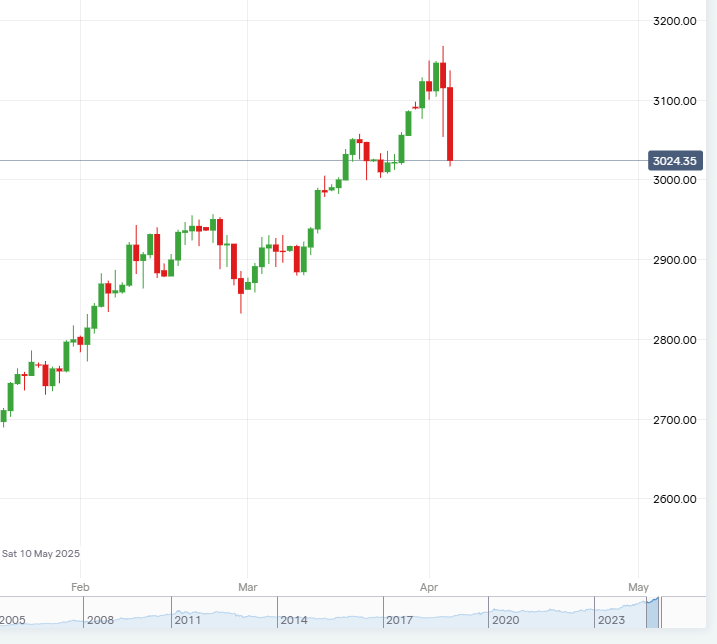Trump’s tariff policies
The Trump administration has imposed a series of tariffs, each with key targets, in the wake of Trump’s protectionist frenzy. The administration urges that such tariffs will shield domestic industries from foreign competition. Trump’s “liberation day” has caused commotion and shifty sentiments amongst investors. Some tariffs are listed below.
| Tariff purpose | Rate | Date Imposed |
| Steel and Aluminium products | 25% | March 12th |
| Most Canadian Goods (PARTIALLY IN EFFECT) | 25% | March 4th |
| Canadian Oil and Gas (DELAYED) | 10% | March 4th |
| All Mexican goods | 25% | March 4th |
| EU imports | 20% | April 9th |
| South Korean Imports | 25% | April 9th |
| Japanese imports | 24% | April 9th |
| Chinese imports | 34% | April 9th |
| Automobile imports | 25% | April 3rd |
| Default tariffs on all imports | 10% | April 5th |
The aggressive augmentation and introduction of tariffs have triggered shifts in investor behaviour. Compelling capital to flow towards safe-haven assets – an indicator of investors predicting macroeconomic instability and low confidence.
Macro-economic expectations shift as cost-push inflation, GDP slowdowns are likely due to the nature of tariffs imposed by Trump.
Adhering to the Efficient Market Hypothesis, by looking at prices of specific assets, we can extract information about the economy. In this article, we take gold as a barometer of market sentiment.
Why there may be economic uncertainty?
The US imports a significant amount of intermediate goods from China, critical for American industries. By imposing tariffs, the cost of these goods rises, leading to a contraction of production. Firms are priced out of key supplies, slowing economic growth as production stagnates, likely causing unemployment as firms seek to reduce the cost per unit of output. Businesses fall short on profits and consumers suffer from higher prices, making the prospect of recession far more tangible,
Such a scenario will prompt investors to move from buying equities to commodities. The reduced profitability of many American companies will lead to gold demand rising and, by extension, the price appreciating.
Tariffs imposed have a distinct effect on market behaviour, causing more gold to be purchased (amongst other commodities) as well as observing a sustained increase in value, days and weeks before the implementation of taxation. We have drawn information indicating that the USA (from the perspective of investors) will endure Economic turmoil in some fashion within the coming months. Whether that be a trade war seen through China’s retaliation to the tariffs imposed, or through supply shocks and lack of economic growth in America.
Understanding safe-haven assets
A safe-haven asset is an investment which can retain value in economic instability. While these assets are susceptible to inflation rates, interest rates and liquidity constraints, their appeal lies in their stability and low volatility.
Demand for safe-haven assets acts contrary to current market investment trends. Such that, when most investors are selling assets to reach margin calls1 or debt obligations2 during economic downturn, investor interest intensifies.
Why Buy Safe-haven assets? Why is gold a safe-haven asset
Investors act in the preservation of profits and capital. To maximize profits, they tend to keep assets until prices rise and sell before prices potentially decline. However, mistiming the market by holding an asset for too long or selling too early can lead to diminished returns.
So as to not expose themselves to uncertainty, investors allocate part of their portfolios3 to safe-haven assets, which are instruments that retain, or increase in value during market stress. Should investors be forced to liquidize assets, their losses are therefore minimized.
Safe-haven assets are supply inelastic. Should demand in the economy increase rapidly, then supply cannot match demand. In the case of gold, this is due to time lags in the refinement and extraction of gold, and the limited supply.
The demand for gold is also roughly consistent year-round, with rises seen when investors buy more of it, increasing its demand. However, the demand for gold rarely ever decreases, meaning that its price rarely ever depreciates and is far more likely to increase.
A factor affecting price variability in the market is how frequently a financial instrument is sold and traded. If an asset is sold and traded more often, it is indicative of emotionally driven factors and short-term profit taking in the market. Since transaction occurs more often, these behaviours also change in tandem, leading to prices being updated more frequently and thus causing price volatility.
Gold is supply inelastic, experiences growing demand and is not traded frequently – all of which leads to the summation of it being a safe-haven asset.
Use of Gold price as a measure of investor sentiment
Gold has been a metric for determining investor sentiment about the economy. Notorious for having a stable price. If investors are in fear of declining capital and profits, they will buy up gold units. Thus, by observing purchase patterns of this commodity, we can judge what investors think will happen.

Gold price from 20th January to April 4th
Theres a clear upwards trend, gold prices (per unit) to circa $3100 per ounce. However, please note that large red candle stick at the end.
Negligible changes in supply and liquidity constraints for gold indicate that currently its price is dictated by investor sentiment. Gold has a low (or negative) beta value4, indicating its price stubbornness with market fluctuations – despite this, drastic increases in gold prices in recent days (till the large red candlestick on April 3rd and 4th) indicate investors intending to buy gold, anticipating uncertainty.
However, in times of widespread sell-off in the equities market, brokers force investors to add funds to meet the margin calls; which compels investors to sell other profitable assets. Given overall depreciation in the equities, the investors usually count on sale of safe-haven assets to prevent forced liquidation of their assets due to margin calls.
This explains the drastic drops in gold prices (the large red candlestick), suggesting a prominent and desperate attempt for investors to meet margin calls, perhaps at the expense of their figurative parachutes.
So, the bearish behaviour from April 3rd to 4th has been attributed to profit-taking and margin calls in other asset classes, likely prompting investors to sell some of their gold holdings to cover losses.5
Definitions and footnotes
- Margin call: A protective measure from brokers that helps traders to prevent losses, if an investor fails minimum requirements, their asset/s are forcibly closed or liquidated ↩︎
- Debt obligations: Legal commitments that a borrower must pay to the lender ↩︎
- Portfolio: A collection of an investor’s financial assets over time ↩︎
- Beta value: A measure of how volatile/risky a stock is compared to the overall market. Gold is a “zero-beta” asset
BETA = 1: Stock price tends to move in line with the market.
BETA > 1: stock is more volatile than the market, and price fluctuates more than the market.
BETA < 1: The stock is less volatile than the market, and fluctuates less than the market. ↩︎ - Source: https://www.reuters.com/markets/commodities/safe-haven-gold-hits-record-peak-trump-announces-sweeping-tariffs-2025-04-03/ ↩︎

